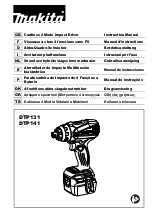
6
•
When operating a charger outdoors, always provide a dry location and use an
extension cord suitable for outdoor use.
Use of a cord suitable for outdoor use
reduces the risk of electric shock.
•
Do not place any object on top of the charger or place the charger on a soft
surface that might block the ventilation slots and result in excessive internal
heat.
Place the charger in a position away from any heat source. The charger is
ventilated through slots in the top and the bottom of the housing.
•
Do not operate the charger with a damaged cord or plug.
•
Do not operate the charger if it has received a sharp blow, been dropped or
otherwise damaged in any way.
Take it to an authorized service center.
•
Do not disassemble the charger; take it to an authorized service center when
service or repair is required.
Incorrect reassembly may result in a risk of electric
shock, electrocution or fire.
•
Disconnect the charger from the outlet before attempting any cleaning. This
will reduce the risk of electric shock.
Removing the battery pack will not reduce
this risk.
•
NEVER
attempt to connect 2 chargers together.
•
The charger is designed to operate on standard 230 V household electrical
power. Do not attempt to use it on any other voltage.
This does not apply to the
vehicular charger.
Chargers
Your tool uses a D
E
WALT charger. Be sure to read all safety instructions before using
your charger. Consult the chart at the end of this manual for compatibility of chargers
and battery packs.
Charging Procedure (Fig. 1)
FIG. 1
F
1. Plug the charger into an appropriate outlet before
inserting the battery pack.
2. Insert the battery pack (F) into the charger, as
shown in Figure 1, making sure the pack is fully
seated in charger. The red (charging) light will
blink continuously, indicating that the charging
process has started.
3. The completion of charge will be indicated by the
red light remaining ON continuously. The pack is
fully charged and may be used at this time or left
in the charger.
Indicator Light Operation
PACK CHARGING
PACK CHARGED
x
HOT/COLD DELAY
PROBLEM PACK OR CHARGER
PROBLEM POWERLINE
Charge Indicators
This charger is designed to detect certain problems that can arise. Problems are indicated
by the red light flashing at a fast rate. If this occurs, re-insert the battery pack into the
charger. If the problem persists, try a different battery pack to determine if the charger
is working properly. If the new pack charges correctly, then the original pack is defective
and should be returned to a service center or other collection site for recycling. If the new
battery pack elicits the same trouble indication as the original, have the charger and the
battery pack tested at an authorized service center.
HOT/COLD DELAY
This charger has a hot/cold delay feature: when the charger detects a battery that is
hot, it automatically starts a delay, suspending charging until the battery has cooled.
After the battery has cooled, the charger automatically switches to the pack charging
mode. This feature ensures maximum battery life. The red light flashes long, then
short while in the hot/cold delay mode.
LEAVING THE BATTERY PACK IN THE CHARGER
The charger and battery pack can be left connected with the charge indicator showing
Pack Charged.
WEAK BATTERY PACKS:
Weak batteries will continue to function but should not be
expected to perform as much work.
FAULTY BATTERY PACKS:
This charger will not charge a faulty battery pack. The
charger will indicate faulty battery pack by refusing to light or by displaying problem pack
or charger.
Summary of Contents for DCF886-XE
Page 1: ...DCF886 XE 18V 6 35 mm 1 4 BRUSHLESS CORDLESS IMPACT DRIVER INSTRUCTION MANUAL ...
Page 2: ......
Page 14: ......
Page 15: ......


































